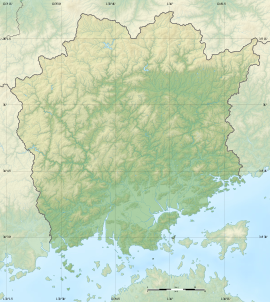67:
39:
74:
46:
328:
have been conducted since 2003, revealing that the midden covers an area of about 100 meters north-to-south and about 80 meters east-to-west, making this the largest known shell midden in western Japan. It dates from the early Jōmon period and continued until the end of the Jōmon period. The shell
336:
have also been found in the swampy area at the tip of the hill. From the types of shells at various layers in the midden, it was possible to determine that the target areas for collecting shellfish changed from tidal flats in the early Jōmon period, to rocky reefs in the middle Jōmon period, to a
270:(approximately 4000 to 2500 BC), sea levels were five to six meters higher than at present, and the ambient temperature was also 2 deg C higher. During this period, the Kantō region was inhabited by the
340:
Twenty-five sets of human remains were found within the midden, with the bones placed in a crouching position. These include the remains of a woman with a fetus. A large amount of
337:
wide range of tidal flats and rocky reefs in the late Jōmon period, and again to tidal flats in the final Jōmon period, corresponding to changes in the environment and sea levels.
352:
for 'Hikozaki-style earthenware'. The excavated items include accessories such as bracelets made from shells and bones, as well as shells, and animal and fish bones.
66:
375:
496:
123:
38:
501:
491:
433:
325:
333:
481:
299:
307:
227:
243:
111:
318:
of Japan. The
Hikozaki Shell Mound is located on the south coast of former Kojima Bay facing the
255:
239:
231:
197:
97:
429:
463:
486:
356:
341:
311:
235:
319:
271:
267:
175:
348:
were also discovered. The earthenware had a distinctive pattern, making this midden the
455:
314:
and habits of Jōmon society. Most of the 2400 known shell middens are found along the
475:
315:
287:
295:
395:
345:
138:
125:
349:
283:
363:
360:
303:
322:. This area is noted for its dense concentration of ancient middens.
275:
251:
159:
330:
291:
247:
101:
279:
306:
associated with the now-vanished inhabitants, and these
329:
layer had a thickness of 1.7 meters in some locations.
355:
The site is located about five minutes on foot from
186:
181:
171:
166:
154:
117:
107:
93:
398:(in Japanese). Agency for Cultural Affairs (Japan)
274:, many of whom lived in coastal settlements. The
219:
213:
426:(国指定史跡事典) National Historic Site Encyclopedia
8:
73:
45:
19:
18:
419:
417:
415:
413:
376:List of Historic Sites of Japan (Okayama)
278:associated with such settlements contain
387:
254:in western Japan, and was designated a
424:Isomura, Yukio; Sakai, Hideya (2012).
16:Ancient shell midden in Okayama, Japan
7:
396:"彦崎貝塚work=Cultural Heritage Online"
310:, provide a useful source into the
14:
250:. It contains the largest known
230:in the Hikozaki neighborhood of
72:
65:
44:
37:
198:National Historic Site of Japan
56:Show map of Okayama Prefecture
1:
497:History of Okayama Prefecture
464:Okayama Prefecture home page
81:Hikozaki Shell Mound (Japan)
266:During the early to middle
220:
518:
326:Archaeological excavations
214:
194:
31:
24:
334:underground storage pits
502:Historic Sites of Japan
492:Shell middens in Japan
456:Okayama City home page
256:National Historic Site
139:34.54944°N 133.83528°E
209:Hikozaki Shell Mound
53:Hikozaki Shell Mound
20:Hikozaki Shell Mound
228:archaeological site
144:34.54944; 133.83528
135: /
21:
240:Okayama Prefecture
187:Public access
98:Minami-ku, Okayama
205:
204:
84:Show map of Japan
509:
468:
460:
443:
442:
439:
421:
408:
407:
405:
403:
392:
357:Hikosaki Station
225:
223:
221:Hikozaki kaizuka
217:
216:
150:
149:
147:
146:
145:
140:
136:
133:
132:
131:
128:
85:
76:
75:
69:
57:
48:
47:
41:
22:
517:
516:
512:
511:
510:
508:
507:
506:
472:
471:
466:
458:
452:
447:
446:
440:
436:
423:
422:
411:
401:
399:
394:
393:
389:
384:
372:
320:Seto Inland Sea
264:
234:of the city of
211:
201:
200:
143:
141:
137:
134:
129:
126:
124:
122:
121:
89:
88:
87:
86:
83:
82:
79:
78:
77:
60:
59:
58:
55:
54:
51:
50:
49:
27:
17:
12:
11:
5:
515:
513:
505:
504:
499:
494:
489:
484:
474:
473:
470:
469:
461:
451:
450:External links
448:
445:
444:
434:
409:
386:
385:
383:
380:
379:
378:
371:
368:
288:mollusc shells
263:
260:
203:
202:
196:
195:
192:
191:
188:
184:
183:
179:
178:
173:
169:
168:
164:
163:
156:
152:
151:
119:
115:
114:
109:
105:
104:
95:
91:
90:
80:
71:
70:
64:
63:
62:
61:
52:
43:
42:
36:
35:
34:
33:
32:
29:
28:
25:
15:
13:
10:
9:
6:
4:
3:
2:
514:
503:
500:
498:
495:
493:
490:
488:
485:
483:
480:
479:
477:
467:(in Japanese)
465:
462:
459:(in Japanese)
457:
454:
453:
449:
441:(in Japanese)
437:
431:
427:
420:
418:
416:
414:
410:
397:
391:
388:
381:
377:
374:
373:
369:
367:
365:
362:
358:
353:
351:
347:
343:
342:Jōmon pottery
338:
335:
332:
327:
323:
321:
317:
316:Pacific coast
313:
309:
305:
301:
297:
293:
289:
285:
281:
277:
273:
269:
261:
259:
257:
253:
249:
245:
244:San'yō region
241:
237:
233:
229:
222:
210:
199:
193:
189:
185:
180:
177:
174:
170:
165:
161:
157:
153:
148:
120:
116:
113:
112:San'yō region
110:
106:
103:
99:
96:
92:
68:
40:
30:
23:
482:Jōmon period
425:
400:. Retrieved
390:
354:
339:
324:
298:, and other
272:Jōmon people
268:Jōmon period
265:
252:shell midden
208:
206:
176:Jōmon period
162:, settlement
346:stone tools
246:of western
142: /
130:133°50′07″E
118:Coordinates
476:Categories
435:4311750404
382:References
286:material,
258:in 2008.
190:Yes (park)
182:Site notes
127:34°32′58″N
350:type site
300:artifacts
284:botanical
242:, in the
232:Minami-ku
402:11 March
370:See also
364:Uno Line
308:features
304:ecofacts
262:Overview
94:Location
487:Okayama
428:. 学生社.
361:JR West
359:on the
296:lithics
276:middens
236:Okayama
172:Periods
167:History
432:
292:sherds
226:is an
160:midden
158:shell
108:Region
331:Acorn
312:diets
248:Japan
102:Japan
430:ISBN
404:2020
344:and
302:and
280:bone
215:彦崎貝塚
207:The
155:Type
26:彦崎貝塚
478::
412:^
366:.
294:,
290:,
282:,
238:,
218:,
100:,
438:.
406:.
224:)
212:(
Text is available under the Creative Commons Attribution-ShareAlike License. Additional terms may apply.

